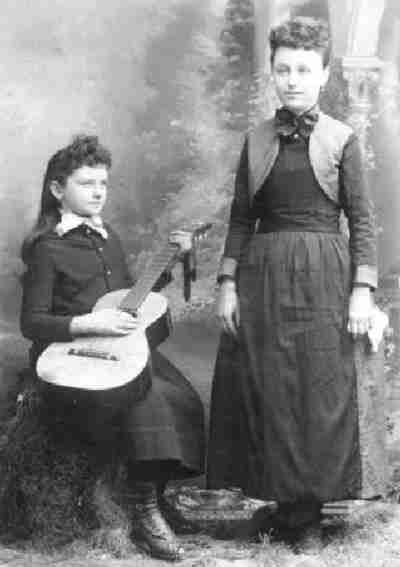
Instrumental Music: Boys' Outfits--Guitars

Figure 1.--A HBC contributor believes the child on the left is a boy. The dress buttons in the front and the buttons are on the right. A girl's dress or blouse would
button on the left. Also, the neck decoration looks like what one would
expect on a boys's dress. The other observation is physical. Look at the
size of the hands compared to the women in the photo. His hands are bigger
and don't look at all feminine. HBC is less sure, but the outfit could have been worn by a boy. Click on the image for a photograph of a boy wearing a very similar outfit. This image was taken in Fairhaven, but I am not sure what state.
|
The guitar and its offshoot the electric guitar is now one of the most popular instruments among boys because of its importance in both rock and country music. Until the 1950s, however, it was not an instrument that mothers would generally select for their sons. In the 19th century it was rarely an instrument a boy would learn for his first instrument.
The Instrument
History
Forms of the guitar existed in ancient times. In the 12 or 13th century the instrument, then made with four strings, was introduced into Spain by the Moors. A fith string was later aadded and in this form the guitar became virtually the national instrument of Spain about the 17th century. The instrument is still often referred to as the Spanish guitar. The instrument became popular throught Europe in the 18th century and was brought to America both by immigrants and by the Mexican population of the southwest.
Description
The guitar is a stringed instrument of the lute family. It has a long fretted neck along which are stretched six strings. Traditiomllu three of the strings were catgut and three were silk wound with wire. The strings are tuned upward from E (one line below th bass clef) as follows: E, A, D, G, B, and E (first line of the treble clef. The guitar has a range of three octaves.
Playing
The instrument is played by plucking the strings with the fingers of the right hand while those of the left hand stop the strings at the various frets to produce the different tones or chords. This is not easy for a young child to manage, meaning that few yonger children can learn a guitar.
Utility
The guitar's soft tones makes it a particularly suitable instrument for the accompaniment of voices, but it is also used for playing music independently and has been played in solo recitals by such virtuosos as the Spanish mussician Andrés Segovia.
Volume
Musical performances in the 19th century were characterized by
ever-larger concert settings and
ensembles. Musicians needed louder and
more powerful instruments, which
became possible by using new materials
and designs.
The introduction of steel strings in
the 19th century meant not only greater
volume, but greater tension on
instruments. The traditional flattop guitar
began to change in size and shape as a
steel-string instrument. In addition, an
entirely different design emerged, the
stronger--and louder--archtop.
In the 1920s, as public dance music became more popular and the infant recording industry required high volume to capture a musical performance, guitar makers increased their
efforts to develop ever-louder guitars. Some people continued experimenting with larger sizes and metal bodies; other innovators started to focus on electricity as a possible aid. This eventually led to the delectric guitar.
Chronology
Gender
The guitar is an instrument played by both boys and girls. HBC believes, however, that many more boys played the guitar than girls. Girls were particularly unlikely to play the guitar in the 19th century.
Social Class
Affluent families of English or German origin usually chose more clasical instuments for boys to learn. American cjildren learning the guitar until relatively recently would have been Mexican American or families from the Apalachen or southwestern states. Thus there are very few available historical images of American boys learning the guitar.
Clothing
The fact that younger children could not play the guitar and that affluent families probably chose other instruments suggess that most boys were breeched before beginning to learn the guitar. The picture above, however, may well have been a boy and HBC believes that American boys in the 19th century were more likely to play the guitar than girls.
As the guitar became a virtual cultural icon in America during the 1950s, it was jeans, especially tight fitting ones that became strongly associated with the guitar.
Christopher Wagner
histclo@lycosmail.com
Related Chronolgy Pages in the Boys' Historical Web Site
[Main Chronology Page]
[The 1880s]
[The 1930s]
[The 1940s]
[The 1950s]
[The 1960s]
[The 1970s]
[The 1980s]
Navigate the Historic Boys' Clothing Web style pages:
[Kilts]
[Caps]
[Sailor suits]
[Sailor hats]
[School uniform
[Scout
Created: January 20, 2000
Last updated: January 20, 2000


